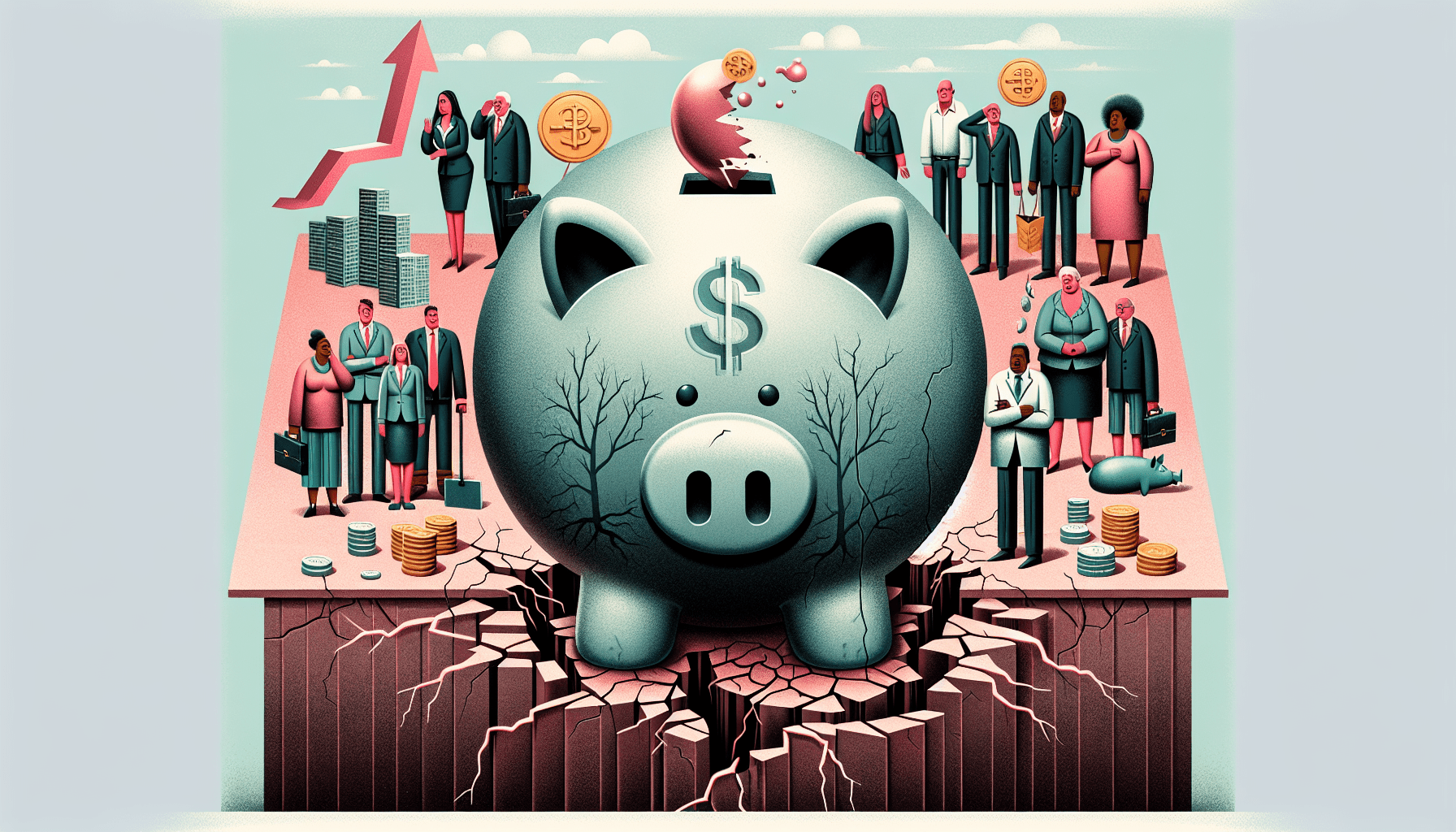Imagine a world where debt is like a dark cloud looming over every decision, every investment, every possibility. This is the reality that the United States currently faces with its high national debt. As the numbers continue to climb, it’s important to understand the potential risks that come with this burden. In this article, we will explore the potential consequences of a high US national debt and the impact it can have on our economy, our future, and ultimately, our wallets. Strap in for a journey through the intricacies of a financial dilemma that affects us all.

The concept of US National Debt
The US National Debt refers to the total amount of money owed by the United States government to creditors, including individuals, foreign governments, and institutions. It consists of both domestic and foreign debt. It is important to understand the concept of national debt as it plays a significant role in shaping the future of the US economy.
Definition of national debt
National debt is the accumulation of budget deficits over time. A budget deficit occurs when the government spends more money than it receives in revenue. To finance this deficit, the government issues Treasury bonds, notes, and bills, which are sold to investors. These bonds are essentially IOUs that promise to repay the principal amount plus interest to the bondholders.
Understanding how the US accrues national debt
The US accrues national debt through various processes. One primary driver of debt accumulation is government spending that exceeds tax revenues. This can be seen during periods of economic downturn or when there is a need for increased government expenditure, such as during wars or economic crises. Additionally, factors such as tax policies, social programs, and defense spending contribute to the accumulation of debt.
Historical context of national debt increases
Over the years, the US national debt has experienced significant increases. Historical events, such as major wars, economic recessions, and financial crises, have played a crucial role in driving up the debt levels. For instance, during World War II, the government increased spending to finance military operations, leading to a substantial increase in the debt. Economic downturns, such as the Great Recession in 2008, have also contributed to escalating debt levels as the government implemented fiscal policies to stimulate the economy.

Impact on Future Generations
The escalating national debt poses significant risks to future generations. One of the most concerning risks is the burden of generational borrowing. As the debt accumulates, future taxpayers will be responsible for repaying the debt and servicing the interest on it. This can potentially lead to higher taxes and reduced disposable income for future generations.
Moreover, the liabilities associated with servicing the debt can place a strain on essential programs such as retirement and social security. If a significant portion of the government’s budget is allocated to servicing debt, there may be reduced funding available for these crucial programs, potentially affecting the financial well-being of retirees and the elderly.
Risk of Inflation
The relationship between national debt and inflation is complex. While there is no direct correlation between the two, there are potential inflationary risks associated with high levels of national debt. As the government increases spending to finance the debt, it may resort to printing more money, which can lead to an increase in the money supply and inflationary pressures.
Moreover, a large debt burden can devalue the national currency, in this case, the US Dollar. If investors lose faith in the government’s ability to manage its debt, they may seek alternative currencies or assets, leading to a depreciation of the US Dollar. This can have adverse effects on the purchasing power of individuals and businesses, potentially causing economic instability.
Another concerning risk is the potential for hyperinflation due to high debt levels. If the government is unable to manage its debt and implement effective fiscal policies, it could create an environment of unchecked inflation, resulting in skyrocketing prices and eroding the value of savings and investments.

Impacts to Interest Rates
High national debt can have significant implications for interest rates. When the government increases borrowing to finance the debt, it competes with other borrowers in the market, increasing demand for loanable funds. This heightened demand can drive up interest rates as lenders seek higher returns on their investments.
Rising interest rates can have far-reaching consequences for businesses and individual consumers. Businesses may face increased borrowing costs, leading to reduced investment and slower economic growth. Similarly, individual consumers may experience higher interest rates on mortgages, auto loans, and credit cards, which can limit their purchasing power and potentially contribute to economic slowdown.
The housing market can also be impacted by higher interest rates. As borrowing costs increase, potential homebuyers may be deterred from entering the market, leading to decreased demand for housing. This can have a dampening effect on the real estate sector and may contribute to a slowdown in economic activity.
Risk to Economic Growth
A high national debt can pose risks to economic development. When the government allocates a significant portion of its budget towards debt servicing, it may have less capital available for investments in infrastructure, education, research and development, and other initiatives that stimulate economic growth.
Moreover, there is a link between national debt and unemployment. As debt increases, the government may resort to implementing austerity measures, such as reduced government spending and increased taxes, to curb the debt levels. These measures can lead to a decrease in aggregate demand, potentially resulting in job losses and increased unemployment rates.
Additionally, high levels of debt can limit a government’s ability to respond effectively to future economic downturns. If there is a need for increased government spending to stimulate the economy during a recession, a heavily indebted government may lack the fiscal capacity to do so, further exacerbating the economic downturn.

Risk to National Security
The national debt can have implications for national security. A high level of debt can limit military spending, potentially undermining national defense capabilities. If a significant portion of the government’s budget is allocated to debt servicing, there may be limited resources available for investment in defense infrastructure, technological advancements, and personnel training.
Furthermore, a substantial portion of the US national debt is held by foreign entities. This poses a risk of foreign influences on US economic policies and potentially compromises the country’s geopolitical capabilities. If foreign creditors exert influence on US economic decision-making, it could hinder the country’s ability to act in its national interest.
Effects on Government Spending and Taxation
A high national debt can lead to higher taxes and reduced public services. As the government seeks to finance the debt, it may resort to increasing taxes on individuals and businesses, placing a greater burden on taxpayers. This can have adverse effects on economic growth and individual households’ financial well-being.
Moreover, the need to service debt can result in reduced investment in infrastructure projects and other public services. These investments are crucial for the long-term economic development and well-being of a nation. If funding for infrastructure is diverted towards debt servicing, it can lead to deterioration in critical infrastructure systems, such as transportation, communication, and energy, affecting the overall productivity and competitiveness of the economy.
Additionally, important social programs, such as healthcare and education, may face risks due to high debt levels. If a larger portion of the government’s budget is allocated to servicing the debt, funding for these programs may be reduced, compromising the accessibility and quality of essential social services.

Risk of Currency Crisis
A high national debt increases the risk of a currency crisis. A currency crisis occurs when there is a sharp depreciation in the value of a country’s currency, leading to a loss in confidence and trust in the currency. This loss of confidence can trigger a domino effect, with investors and individuals rapidly selling off the currency, further driving down its value.
If the US were to experience a currency crisis, it could have severe consequences for the economy. A depreciating US Dollar could lead to increased import costs, thereby driving up prices for consumers and potentially contributing to inflation. Moreover, a weakened currency can erode the purchasing power of individuals and businesses, reducing their ability to engage in international trade.
The risks posed to international trade due to a currency crisis can also be significant. A depreciating currency can make US exports more affordable for foreign buyers, potentially boosting exports. However, it can also lead to retaliation from other countries, causing trade tensions and potentially harming the US economy, which heavily relies on international trade.
Higher Dependence on Foreign Debt
High levels of national debt can result in a greater dependence on foreign entities to finance the debt. As the government seeks to borrow from international investors, particularly from countries holding large sums of US debt, it becomes increasingly reliant on foreign capital to sustain its spending habits. This dependence can compromise national sovereignty and limit the government’s ability to make independent economic decisions.
Furthermore, owing money to foreign entities can pose risks to national security. If a significant portion of a country’s debt is held by foreign governments or institutions, their economic interests may intersect with political interests. This can potentially lead to foreign influences on economic policies and compromise the government’s ability to act in the best interest of its citizens.
Dependence on foreign capital also exposes the country to risks associated with changing global economic dynamics. Economic instability or shifts in geopolitical dynamics can impact foreign investors’ willingness to lend to a heavily indebted nation. In times of global economic turbulence, access to foreign financing may become limited, potentially exacerbating the challenges faced by an already burdened economy.
Risk of Default
Default occurs when a country is unable to meet its financial obligations, such as repaying its debt and interest payments. A default by the US on its national debt would have severe consequences for the global economy, given the country’s position as a major economic power and the US Dollar’s status as the world’s reserve currency.
The potential impacts of a US national debt default cannot be understated. In the event of a default, global financial markets would face significant turmoil, leading to a loss of investor confidence and a potential freeze in credit markets. This could result in a contraction in lending, reduced business investment, and a decline in economic activity worldwide.
Additionally, a US default could trigger a domino effect, causing a ripple effect on other economies and leading to a global recession. The interconnected nature of the global financial system means that the consequences of a US default would extend far beyond its borders, affecting economies and livelihoods around the world.
In conclusion, the risks associated with a high US national debt are multifaceted and have far-reaching implications. From generational burdens and inflationary risks to impacts on interest rates, economic growth, national security, government spending, and potential default, the national debt poses significant challenges to the stability and prosperity of the US economy. It is crucial for policymakers to address these risks through prudent fiscal management, responsible spending, and long-term debt reduction strategies to ensure a sustainable and secure economic future for the nation.
